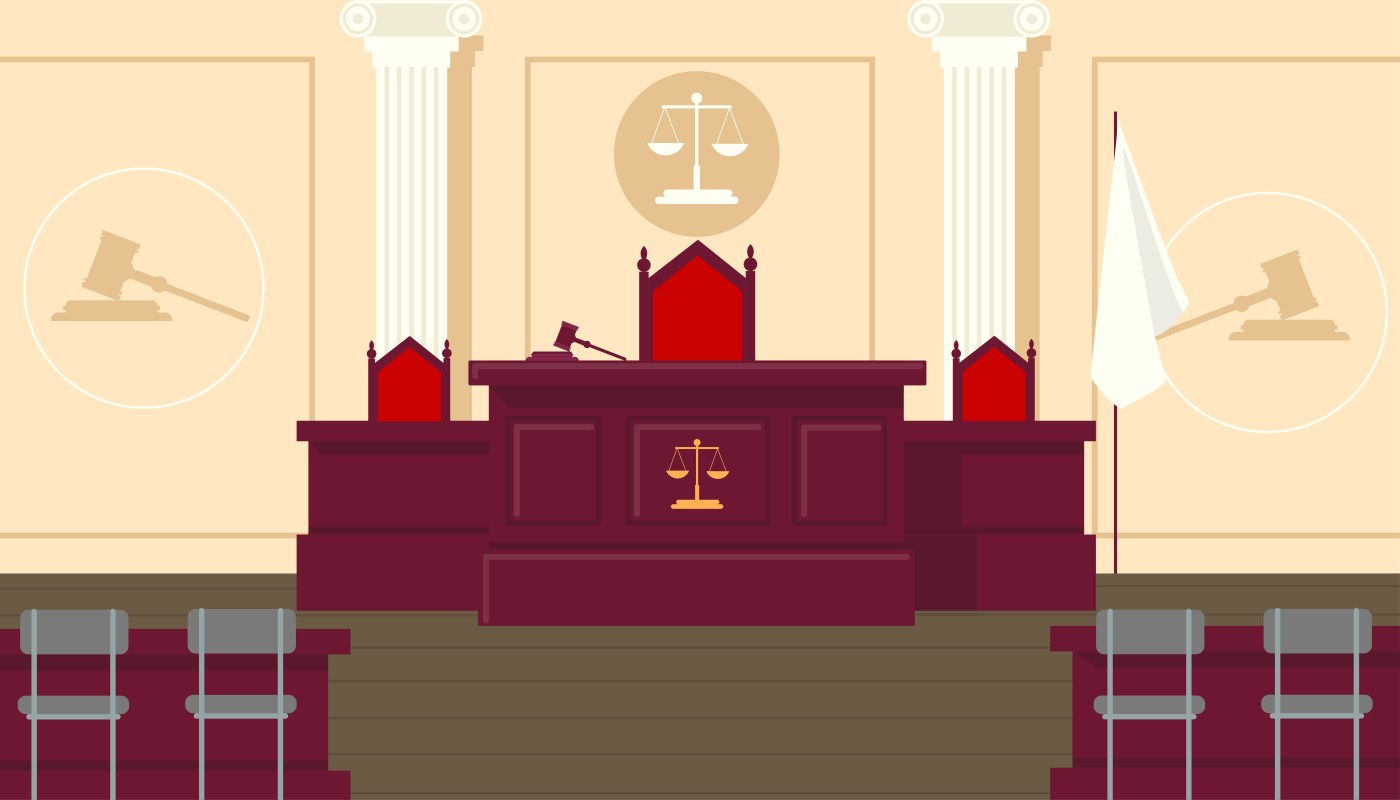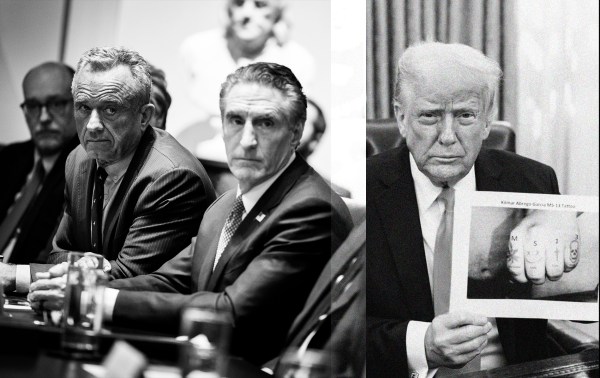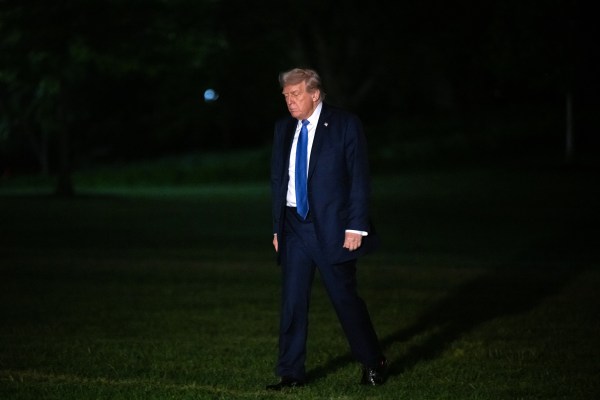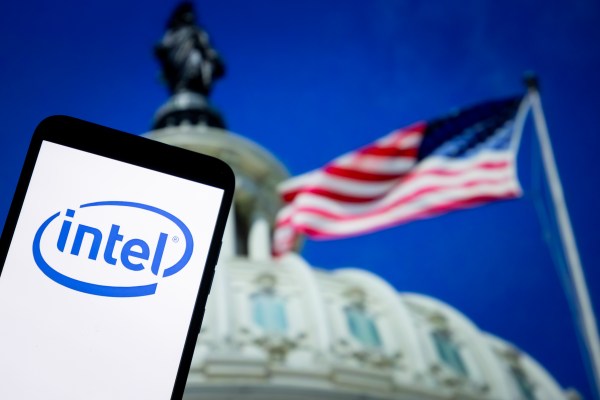Two federal judges in high-profile deportation cases have asked the Trump administration to show cause why it should not be held in contempt of court over its appointees’ refusal to follow court orders. Are we finally getting some sort of pushback on the administration’s seemingly calculated strategy of moving fast and breaking so many laws that it’s hard for opponents to keep up?
That there is abundant evidence of contempt, in both the legal and the colloquial sense, can hardly be denied. But the administration’s defiance of court orders is less likely to come across as a single calamitous event, like the collapse of a dam, than it is to take the form of an extremely tedious cat and mouse game. And when you look at how a contempt showdown is likely to work, it’s hard to get one’s hopes up—yet such a showdown could still serve a useful purpose.
In March, Judge James Boasberg convened a hearing to decide whether removing hundreds of detained individuals to El Salvador was lawful, only to discover that planes carrying out the mission took off after the hearing began. The government’s lawyers argued that they’d been under no obligation to turn the planes around because, at that point, he’d given an oral order and not put it into writing. Afterward, Salvadorean strongman Nayib Bukele mocked the authority of the U.S. courts by tweeting “Oopsie … too late” alongside a laughing emoji, which—to make matters more galling—was then shared by the accounts of Secretary of State Marco Rubio and Trump adviser Elon Musk.
All in all, Boasberg wrote in a 46-page memorandum opinion, the available evidence “strongly suggests” a “desire to outrun the equitable reach of the Judiciary,” while the administration’s simultaneous messaging “deliberately and gleefully” signaled willful disobedience.
Scarcely less blatant was the contempt in the other high-profile case, that of Kilmar Abrego Garcia, mistakenly renditioned to El Salvador despite a court order. Along with an unconvincing quibble about what was meant by a Supreme Court order to “facilitate” Abrego Garcia’s return—the Department of Homeland Security and Department of Justice took the view that doing nothing at all constituted compliance—the departments then stonewalled Judge Paula Xinis’ subsequent orders to furnish more information, in what Xinis found was “deliberate evasion” and a “willful” and “bad faith” refusal to comply.
As in the case before Judge Boasberg, the administration seemed intent on taunting the court on social media, with an April 18 White House post declaring that Abrego Garcia was “never coming back,” and Trump and Bukele themselves staging a wink-wink buddy act each pretending that the other would have to be the one to decide to free him. In a later interview, Trump appeared to undercut his own earlier line by conceding that he “could” get Abrego Garcia back.
It's hard to escape the conclusion that the Trump administration actually wants the judges in these cases to hold them in contempt—and, by extension, that it thinks it would win such a showdown. Would it?
Courts have some impressive powers they can wheel out against contempt, but the chance that they will use them purely to punish smirks, memes or emojis is basically zero. Executive departments and agencies constitute what’s called a coordinate branch of government, and every federal judge is likely to handle them with utmost caution, even when the respect seems to run only one way.
Judges Boasberg, Xinis, and those that come after are therefore likely to build a meticulous record and ground any contempt orders on noncompliant actions rather than mere insolent words or attitudes.
Further, court orders commonly bring with them at least gray areas and uncertainties defendants can exploit. Typical among these are quibbles about wording, and claims that a certain result can’t be achieved, takes more time, or requires cooperation from someone not subject to the order—all issues that in fact have arisen in the rendition cases.
Sanctions against individuals are among the most important contempt powers, but to assign them judges need to find out who, exactly, are the decision makers. Part of the Trump administration’s hardball approach has been to blur lines of authority and the identity of responsible persons, a tactic also seen in suits seeking to restrain Elon Musk’s so-called Department of Government Efficiency (DOGE).
Judges can unleash some genuinely formidable sanctions against recalcitrant private litigants—most of which don’t work nearly as well when aimed at agencies of the federal government. A classic contempt sanction, for example, is escalating fines that mount for each day or week the target fails to comply. If a court tries this against an employee of a defiant federal agency, the agency will presumably reimburse him. Should it hit the agency itself with a fine large enough to give the agency pause instead of an individual, what happens next? If the agency is acting at the behest of the White House, does it seek reimbursement from the general treasury? Or, alternatively, might it cut popular programs and blame that on the court? Either way, the money would in some sense just get shifted from the taxpayers’ left pocket to their right—not exactly a finely tuned incentive.
Courts faced with defiant private litigants can simply threaten to decide the underlying lawsuit against them. That’s not so easy when the government is a litigant, since judges will feel a responsibility to see the underlying dispute resolved in the way that is most consistent with law and its public purposes, not just the way that makes the government feel punished.
Courts can and do imprison private litigants, and occasionally state and local officials, for contempt. In most cases the premise is that the one behind bars has the “key to the jail in his own pocket” since complying with the order results in release. One case readers may remember is from Kentucky in 2015, when a federal judge briefly jailed county clerk Kim Davis, who was refusing to comply with an injunction requiring her to issue same-sex marriage licenses following the Supreme Court’s Obergefell decision. Davis could clear the contempt either by issuing the licenses or by quitting the clerk job, and did in fact go free after a deal was struck enabling other county employees to issue those licenses.
What they would do to a county clerk, the federal courts would think long and hard before doing to a Cabinet secretary.
Back in 1951, the general rule that courts don’t jail federal officials for contempt nearly had a striking exception. In a case called Land v. Dollar, the Truman Justice Department had resisted obeying a court order to return to its former private owners a shipping company that had fallen into federal hands. The judge threatened to order the imprisonment of no less than the secretary of commerce, a Cabinet official. When the dispute reached the Supreme Court, one of the more far-seeing justices of that era, Robert Jackson, wrote to say that the court “should exercise utmost care lest it appear to be indifferent to a claim of official disobedience.” After all, Jackson pointed out, the court did not hesitate to let stand strict contempt sanctions levied against everyday litigants who defied court orders. Nor was waffling a proper response: that “some of the Nation's high officials are guilty of contempt of court is not wholesome. The evil influence of such an example will be increased by delay.”
But Jackson was writing only for himself, not for the court. The court majority found grounds to stall enforcement of the sanction and the case subsequently went away when the parties settled.
Yale law professor Nicholas R. Parrillo tells the story of Land v. Dollar in a comprehensive (and these days amazingly timely) 2018 Harvard Law Review article exploring what has happened over the years when federal judges have used their contempt powers against misbehaving agencies.
There weren’t all that many, Parrillo found. And when they did arise, judges almost never resorted to jailing agency leadership. “In the two cases where [federal] officials were actually jailed, it was for only a few hours.” Nor did courts often successfully hit agencies or their officials with fines.
As Justice Robert Jackson observed, this all marks quite a contrast to the jeopardy that ordinary people face when a judge considers them recalcitrant. In a 2008 article in the Cornell Journal of Law and Public Policy, Elizabeth G. Patterson wrote that thousands of people are jailed each day in the United States for failure to pay child support, and while a variety of different laws contribute to that fact, both civil and criminal contempt are important among them. Every day, ordinary people around the country learn the hard way that you just don’t disobey a court order—at least unless your paychecks are signed by Donald Trump.
What leaves federal agencies in such a pampered position is not so much the inhibition of the trial judges as what Parrillo calls the “virtually complete unwillingness” of the higher courts to back up those judges’ sanctions, “at times swooping down at the eleventh hour to rescue an agency from incurring a budget-straining fine or its top official from being thrown in jail.” In practice, he found the appeals courts “unfailingly thwart sanctions in all but a few minor instances.” They are particularly hostile toward even transient imprisonment of officials—in one instance removing a trial judge from a case, citing bias.
It's not that the appeals courts have declared that agencies or their officials enjoy some sort of formal immunity from contempt penalties; indeed, Parrillo finds, they’ve “bent over backward to avoid making” any such pronouncement. Instead they prefer to seize on narrow, technical, and one-off issues to stall threatened penalties, sometimes waiting until the last minute to do so. The Supreme Court itself has had little to say.
You might think this makes seeking contempt sanctions against the government a pointless game, destined to fail. But that’s not how Parrillo sees the tale. On a practical level, he says, agencies did often turn around their misbehavior after a contempt finding. He thinks this relates to a shaming effect: Agencies found it publicly embarrassing to have that kind of spotlight shone on them and adjusted their behavior so as to end the case.
Parrillo was writing in 2018. And the obvious thing that’s changed since then is that we have an administration filled with appointees whose collective superpower seems to be invulnerability to shaming, and which plays to a base that is ready to see defiance of court orders as needed toughness.
We have to expect, therefore, that Trump agencies will move even further into open defiance than they have yet done. This will probably not be uniform across issue areas; even as the administration has insulted and impeded judges in the alien removal cases, it has quietly complied with judges’ orders in some other areas, perhaps because it doesn’t see those other areas as fit-for-Fox base-pleasers.
Even if the administration escapes tangible sanctions for contempt, as it likely will do for the foreseeable future, it may nonetheless pay a price. (For what it’s worth, it’s generally assumed that a president can pardon criminal but not civil contempt.) That price may be diffuse and hard to measure but no less real.
To begin with, its relations with the courts, including the Supreme Court, are likely to deteriorate further. Legal commentators have lately been discussing what’s called the “presumption of regularity” that the government enjoys in court, the “baseline assumption that government officials act lawfully and in good faith,” as Alan Rozenshtein calls it, and that the representations government lawyers make as to the facts and the government’s motivations are accurate. This presumption helps the government win many cases in court; it helped the first Trump administration win some big cases, as commentator Dan Epps has noted.
It took more than two centuries for federal government lawyers to build up that trust before the federal judiciary. It’s taking only weeks for the second Trump administration to squander it.
Besides setting a tone with judges, formal contempt findings will educate the public. Polls indicate that defying court orders, especially when the Supreme Court has weighed in, is quite unpopular even with Republicans, and deeply unpopular among voters generally.
And yet, as we’ve already seen in the rendition cases, nonlawyers often find it hard to cut through the yes-you-did, no-I-didn’t bickering to feel sure of whether the defiant side has genuinely crossed a line into violating the court’s order. That’s where there’s no substitute for a formal finding of contempt, made after appropriate inquiry and especially if it withstands appeal. Such a finding lays down that line for all to see: Yes, it announces, the administration has defied the federal courts.
And then we’ll know where we stand.






Please note that we at The Dispatch hold ourselves, our work, and our commenters to a higher standard than other places on the internet. We welcome comments that foster genuine debate or discussion—including comments critical of us or our work—but responses that include ad hominem attacks on fellow Dispatch members or are intended to stoke fear and anger may be moderated.
With your membership, you only have the ability to comment on The Morning Dispatch articles. Consider upgrading to join the conversation everywhere.